The Chinese Super League was back in July with a distinct competition system. Matches are divided into two stages and held in only two cities. In the first stage, each city will have eight teams. They will fight for the top four of the table in their respective group (city). If they succeed in doing so they will fight for the championship in the next stage, while the others will fight to avoid relegation.
Guangzhou Evergrande is now ranked first in their group. Wei Shihao contributed six goals in five matches and he is the winning factor for Evergrande. The former Liga Nos striker has been widely praised by the Chinese media and is considered to be the next Wu Lei. He is considered to be the next Chinese player capable of playing in the top five European leagues; English Premier League, La Liga, Serie A, Bundesliga and Ligue 1.
In this tactical analysis, we will delve into if Wei Shihao is currently ready to play in one of the top five European leagues. In this scout report, we will examine his playing style to see what he can bring to a team’s tactics. Then we will check his level of play to see if he is capable of playing in those leagues.
Data analysis with Wu Lei
It is not fair to compare the stats for a Chinese Super League player with the stats for European League’s players, since the level and other factors of the Chinese Super League are far below that of the top five European leagues’. Hence, we come up with another method to do the quick data test in this analysis.
Before Chinese striker Wu Lei joined Espanyol and played in La Liga, he played a full season of the 2018 Chinese Super League for Shanghai SIPG. In this case, we think it’s reasonable to compare Wu Lei’s stats in 2018 Chinese Super League with Wei Shihao’s stats this season, to see if this 25-year-old striker has the same level of statistics as Wu Lei. This, to some extent, can manifest if Wei Shihao has reached the threshold of going to play in the top five European Leagues.
The first metrics we will be looking at are closely related to goal contribution. Since they are both strikers, it’s their natural responsibility to put the ball behind the net.
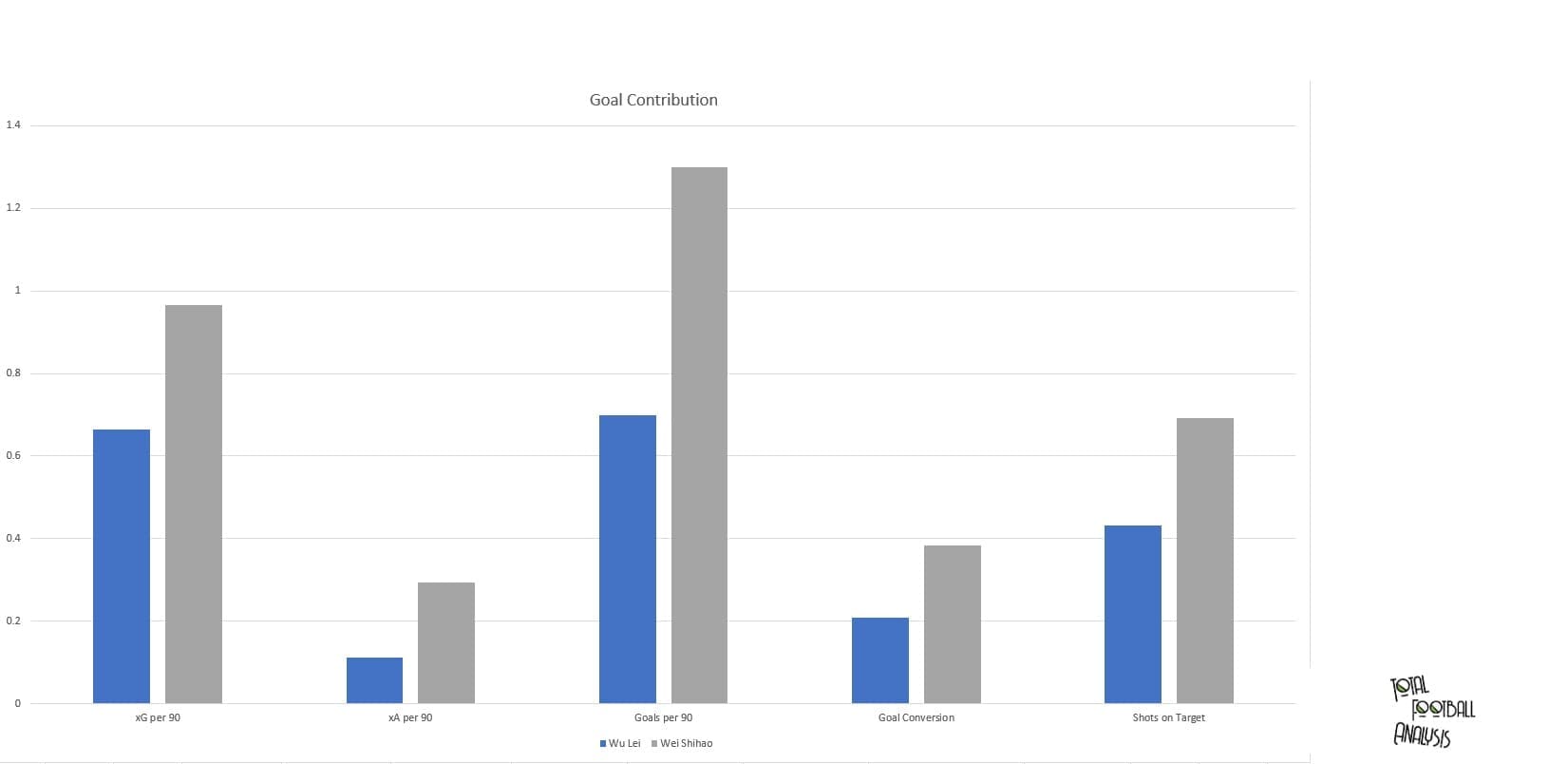
As we can observe from the above bar chart, Wei seems to excel in every aspect of these metrics. He has 0.965 xG per 90 while Wu Lei had 0.665 per 90 in 2018. Their goals per 90 both exceed xG per 90 which means they both score more than expected. Wei has a 0.692 shots on target rate while Wu had 0.431. For the goal conversion, one shot of Wei can produce 0.385 goals whilst Wu’s could produce 0.209 goals. To conclude these first metrics, Wei seems to exceed Wu in every measure. However, the level of the league may have changed over time, and the system of the league this year is quite different from that of 2018. Thus, these factors may affect the statistical output of these two.
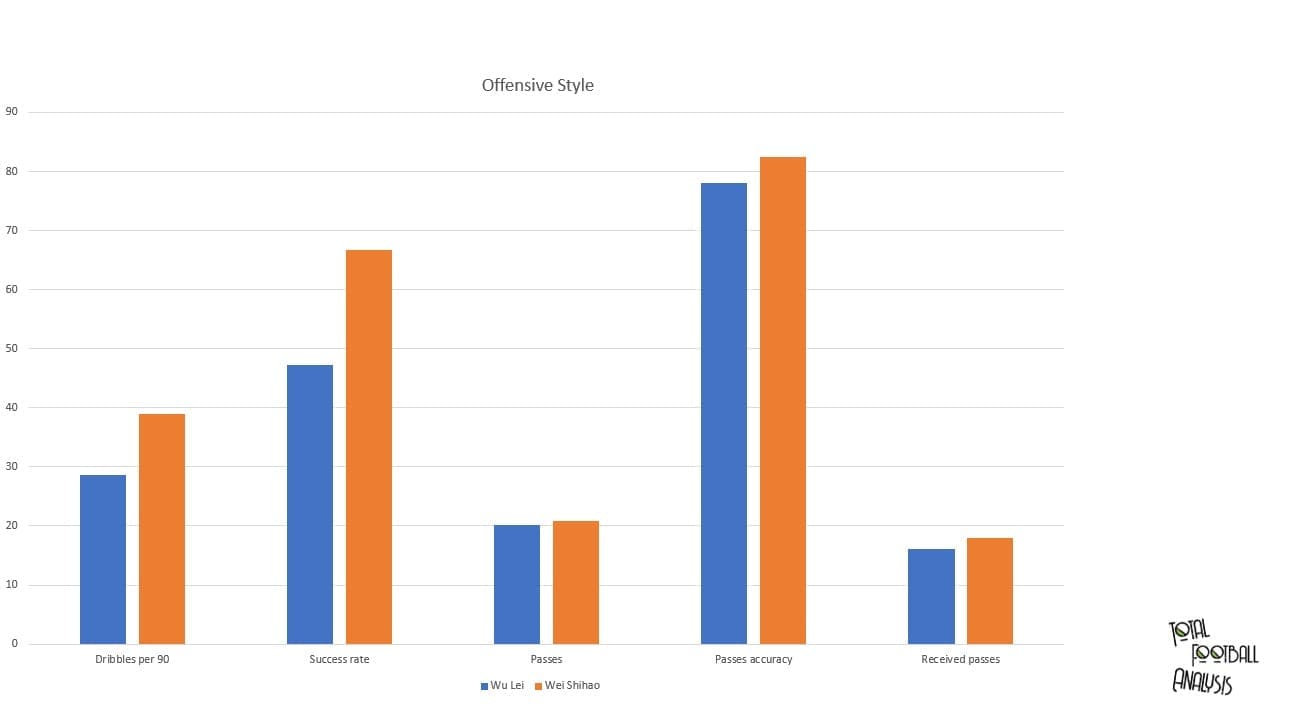
The second group of metrics we will be looking at represent the offensive style of these two strikers. Since these two players have a similar playing style and traits, we will see the difference in their stats.
As you can see from above, they have quite a similar structure in these metrics. The shape and trend across these bars are quite alike. Nevertheless, Wei still seems to exceed Wu’s stats in every metric. Wei has 3.907 dribbles per 90 with the success rate of 66.7%. Wu has 2.861 dribbles per 90 with 0.473 in the success rate. In terms of passes, their stats are almost the same (20 per 90), but Wei is better in accuracy.
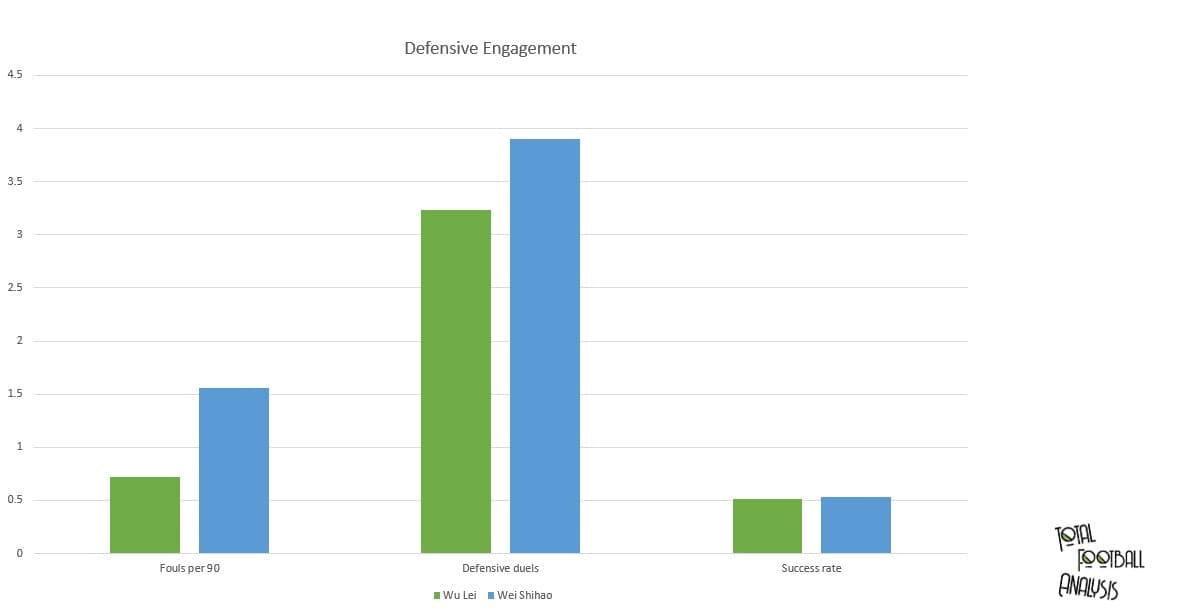
After having the impression of their offensive stats, we will now turn to their defensive output.
Wei still has more defensive duels per 90 than Wu (3.90 than 3.24), while the success rate is almost the same. We also include fouls per 90 here as an indicator for discipline, since Wei is well-known for losing his cool on the pitch. And, as expected, Wei has more than 1.5 fouls per 90 while Wu, who is calm on the pitch, has only 0.7 fouls per 90.
After seeing all these metrics, Wei seems to exceed Wu Lei’s 2018 level from a statistical perspective. However, the level of the league and the competition system has changed quite a bit these two years. Therefore, in the next part of this analysis, we shall eye-test Wei Shihao’s current level.
Style of play
Before we jump into the judgment of his level and whether he is ready for the top five European leagues, we will examine his playing style first. Then we will try to judge his level by eye-testing if he possesses some necessary traits or detailed actions in his kind of playing style.
The 25-year-old right-footed Chinese striker is not very strong in physique, and he is only 178 cm in height. However, despite his small stature, his jumping ability is quite good, enabling him to access the ball first in aerial duels. He has 2.6 aerial duels per 90, with a success rate of 40%. Thus, he can be deployed as a target man flicking on to his teammates who cut in behind the space Wei creates. This can serve as a solution when the team finds it hard to break the pressing block in the back.
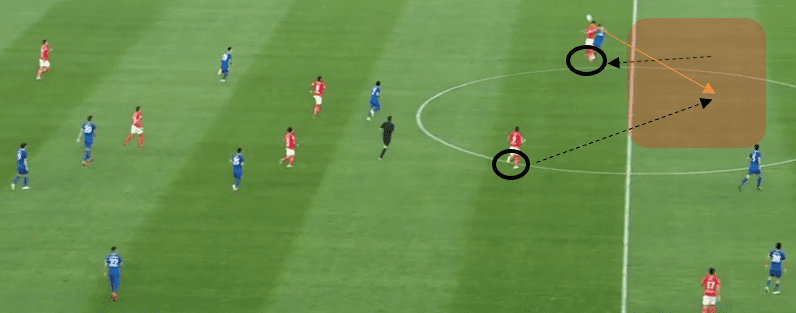
Above is an example of Wei’s aerial ability. Guangzhou Evergrande found it hard to break through the press. So they hit it long to find Wei Shihao upfront. Wei Shihao anticipated the trajectory of the ball and he moved backwards in advance, trying to be the first to access the ball. He jumped up well-timed and as you can see from the picture he jumped quite high. As he moved backwards he managed to create space behind his back. That is when his teammate Ai Kesen cut into the space to receive the ball.
Apart from his aerial ability, his off-the-ball movement is his biggest weapon. He is a typical run-in-behind striker and a play-stretcher. He can exploit the timing to accelerate and run in behind the defensive line. This kind of run can provide his teammate with a direct final pass option, and Wei can finish behind the defensive line. If his teammate chooses not to hit the final pass, then his run can stretch the opponent’s defensive line, creating more space for his teammates to receive and operate between lines. As the defensive line is drawn deeper by Wei’s run, for Wei’s side they can potentially progress the ball into a more advanced area. On top of this, this kind of run will also appear in offensive transition, providing depth for his team. As he is pacey, his run can help the team to exploit the timing and maintain dynamics in offensive transition. Now let’s take a look at an example of his run in attacking.
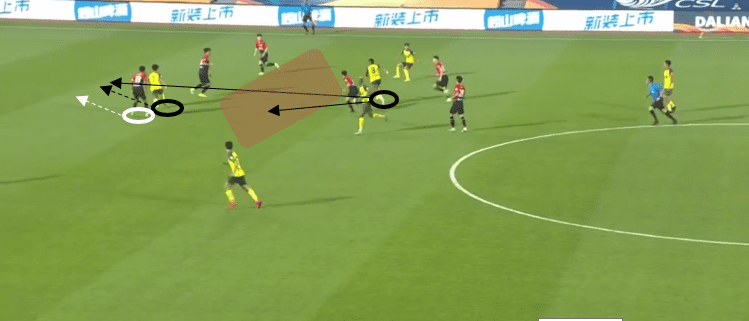
In the above scenario, former Barcelona player Paulinho was on the ball. He was facing forwards and was available to hit the forward pass. Wei read this trigger and started to accelerate, running towards the space behind the defensive line. He primarily served as a final pass option for the Brazilian, whereas it was unavailable since the defender tracked him tightly. Hence, the second function of his run appeared as the defender marked him tightly and was stretched back. Paulinho had more space in front of the defensive line to progress the ball and operate.
Wei Shihao can also be deployed as a left-winger. When he is playing on the left, he will occupy the sideline as his starting position, which provides width in attack. Later as he receives the ball, he will use his right to cut inside, taking on the defenders. His 1v1 ability on the flank is excellent in the Chinese Super League, with 3.90 dribbles per 90 and a success rate of 66.7%. His technique and pace enables him to beat defenders in 1v1 situations. After winning the 1v1 and cutting inside, he can finish in a high quality manner. This individual ability equips the team with a solid scoring weapon as Wei can take on defenders and create scoring opportunities on his own. If it’s not possible to finish after cutting in, he’ll combine with his teammates in the middle and play creatively in zone 14. This adds the unpredictability of the team’s attack and more solution in the finishing stage.
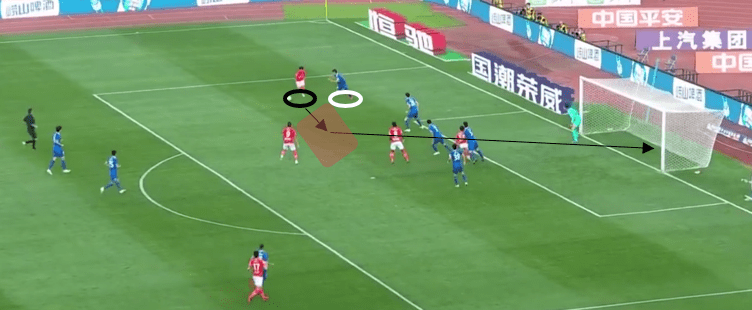
The above image manifests the scenario of Wei cutting inside and then scored. He was on the left flank, 1v1 against the opponent’s right-back. He utilised his quick acceleration to gain territory in his first step of dribbling. The opponent was not able to follow Wei’s pace and gave away the space inside. Therefore Wei had the space to shoot, and he aimed at the bottom far corner. He scored by taking advantage of this 1v1 situation.
Judgment of his level
After knowing what kind of player Wei is, we will now delve into the judgment of his level. There are some common requirements in the top five European leagues for players of this style. For example, a player in one of Europe’s top five leagues should possess decent finishing efficiency, various finishing methods, open body shape when off-the-ball, two runs to create space, good press-resistance level, pressing efficiency with detailed movement etc. In this part, we will examine if Wei possesses some of these crucial attributes.
Firstly, we will take a look at Wei’s finishing level. From the statistical point of view, his goal conversion rate is decent with the stats of 38.46%. This means that almost four of his shots produce a goal. Moreover, his shots on target rate is also excellent at 69.2%.
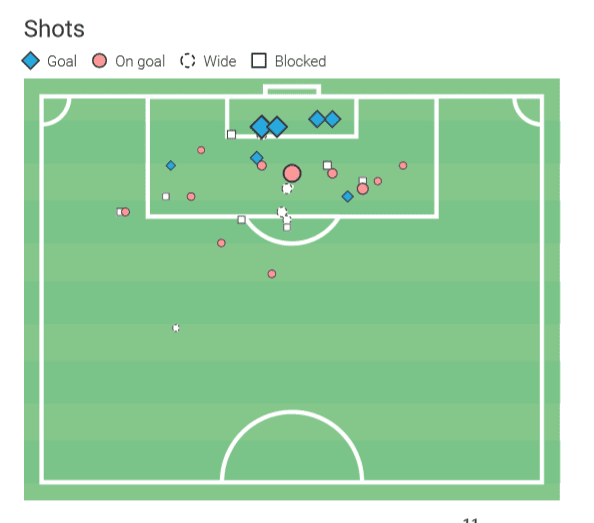
After scanning his finishing-relevant stats, we will see the way he finishes. From the above shot map, we can see that Wei mostly finishes inside the box with his in-behind runs. His tap-ins are well-timed and effective in the goal area. While this map gives us some brief impressions on Wei’s finishing, we will now check with a real match scenario to check his finishing technique.
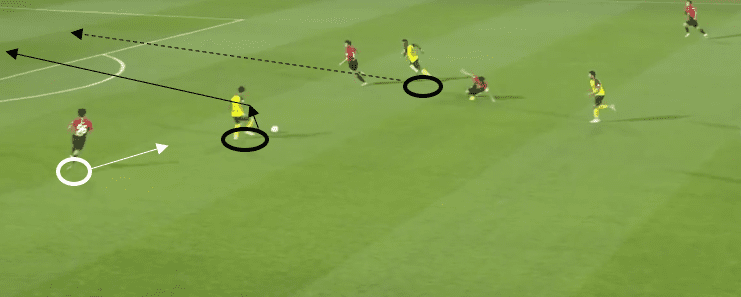
In the above scenario, Wei received the ball from the midfield. He had some time and space in zone 14 while the opponent was running towards him. As the teammate on the right was tightly tracked by the opponent, he was determined to finish on his own. He took two touches in this finishing procedure. He took the first touch forwards to open up his body, which gave him a bigger angle to choose where to shoot. Then the second touch he shot at the goal, aiming at the bottom right corner. Though he didn’t score in this scenario he managed to force the goalkeeper to make the save, which gave Paulinho the chance of taking the rebound and scoring. Thus, his overall finishing skill is of the top five European leagues standard.
Next, we will figure out his pressing skill. Wei is a pacey player, however, his runs in pressing lack the change of speed. As coaches may deliver an essential coaching point in coaching the individual pressing: the change of speed in approaching the opponents “fast-fast-slow-slow”, Wei seems to maintain his run at the same speed. He is either too fast to be beaten or too slow to give pressure on the opponent.
On top of this, Wei can’t make good use of curving runs in pressing. Curving runs are crucial in pressing as they could help eliminate at least one passing option for the ball carrier. Wei seems to forget when to use it and as a result, this allows the opponent’s pivot to receive the ball in the central area. Here is an example of this.
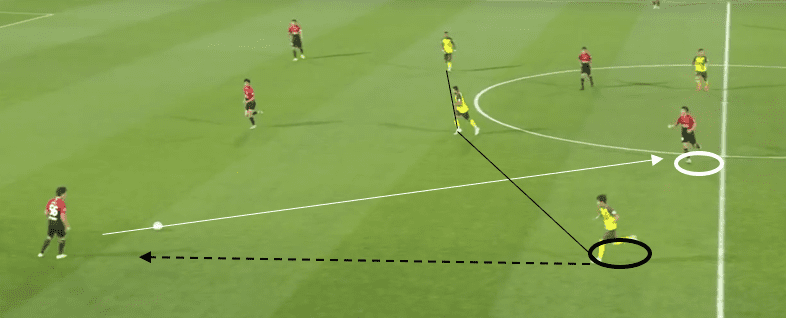
In the above scenario, Evergrande was employing the mid-press tactic. The first pressing line consisted of three players, including Wei, to meet three defenders of the opponent. Wei recognised the trigger to press, whereas he ran in a straight line. He didn’t run in a curve to shadow the pivot behind him, and a passing channel to the pivot was still available. The opponent defender saw the channel and picked the pivot, breaking the first pressing line of Evergrande and successfully progressed the play. Thus, Wei not running in curve may adversely affect the team’s ability to effectively press the opponent and prevent the play from getting forwards.
Now we will delve into the final attribute to judge his level, his press-resistance. In general, he is composed when pressed and he will have some creative solutions when the opponent tries to close him down. The prerequisite for these creative solutions is his open body shape to help him to see more of the pitch.
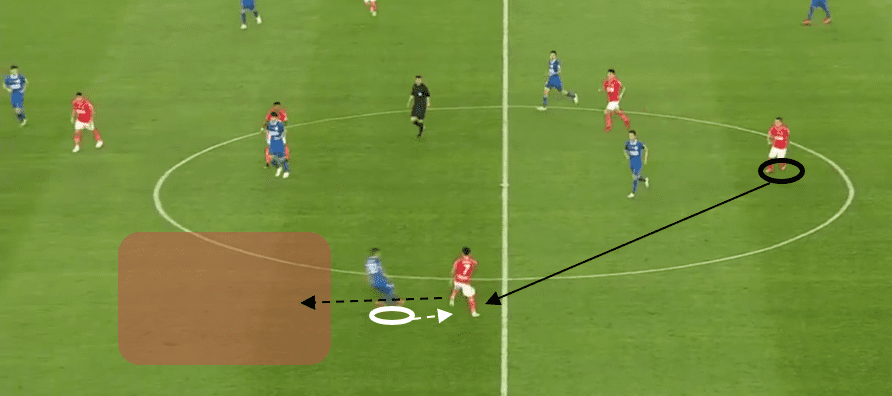
The above is an example. Wei opened his body in advance to see more of the pitch. Then an opponent pressed him but he was way too close to Wei. Wei saw this and also the space behind the presser. Hence he used the outside of his left to take the first touch forwards into that space, beating the opponent and getting into the advanced space. This manifested his composure when pressed and also a good body shape when off-the-ball.
Conclusion
Now we have checked Wei Shihao’s playing style and also a bit of his level in the above analysis. However, other attributes like strength and his character may also affect his performance greatly. In China, he is not only well-known for his skills, but also widely criticised for his bad temper that leads to unnecessary actions and meaningless fouls on the pitch. Thus, factors like this will also affect if he can play in the top five European leagues or not, as discipline may become his problem.
Putting this aside, we think that he is capable of playing as a rotation player in Ligue 1, La Liga or Bundesliga. And he is capable of playing in teams that fight for relegation in these leagues. Moreover, it is also a good choice for him to play in Liga Nos again, as his current level might earn him the starting place in some of Liga Nos’ teams.

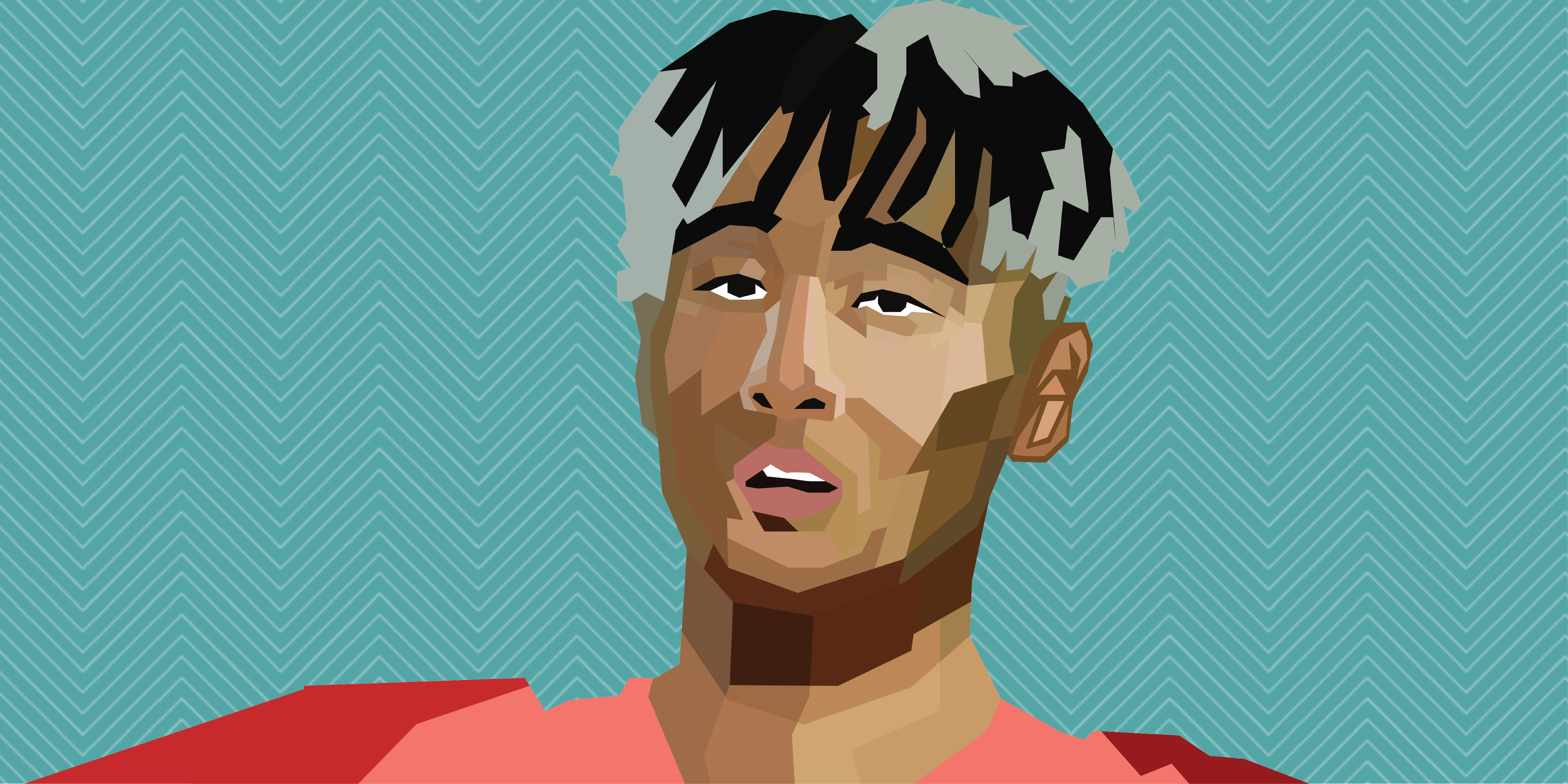



Comments